Mandala Sculpture for the new W Hotel Muscat
This project that began in 2016 was the first opportunity for my team to make a foray into the world of sculpture design. A field that allowed us to confront a greater formal and conceptual freedom and also complexity.
The Objective
This project was born out of a new collaboration with the European architects’ studio Rockwell Group.
The Rockwell team in Madrid was working on the design of the common areas of the new W Hotel in Muscat, the capital of Oman.
On the rooftop terrace of the new building located at the seafront we find the Siddharta Lounge, a Hindu-inspired space where visitors can relax and enjoy the incredible views.
As a focal art piece in this space, Rockwell thought of working on the three-dimensional reinterpretation of a traditional symbol of Hindu and Buddhist culture, the mandala.
Mandalas are representations of deities and paradise with circular drawings composed by a radial repetition of equal elements.

Conceptualization
The most obvious way to translate this two-dimensional symbol into a three-dimensional object was to project it onto a semi-sphere and complete the geometry with two identical pieces. A static piece that reproduces a single symbol.
As great lovers of geometry, at Atelier Mel we immediately began to investigate different polyhedrons that would allow us to decompose the shape so that a radial repetition of the same elements, this time applied in three dimensions, would result in not just one mandala, but several, depending on the observer’s point of view.
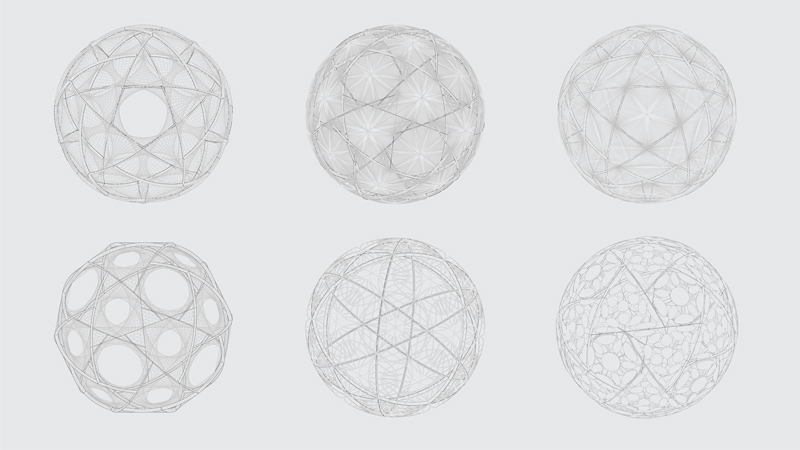
The piece would be viewed from different heights. First from the entrance where the observer would be standing, and then from a seated position, where the observer would be resting on the sofas arranged around the sculpture. The third point of view would be the zenithal view, not because the observer can see the piece from above but because a hidden light at the top of the piece would project a new mandala on the floor.
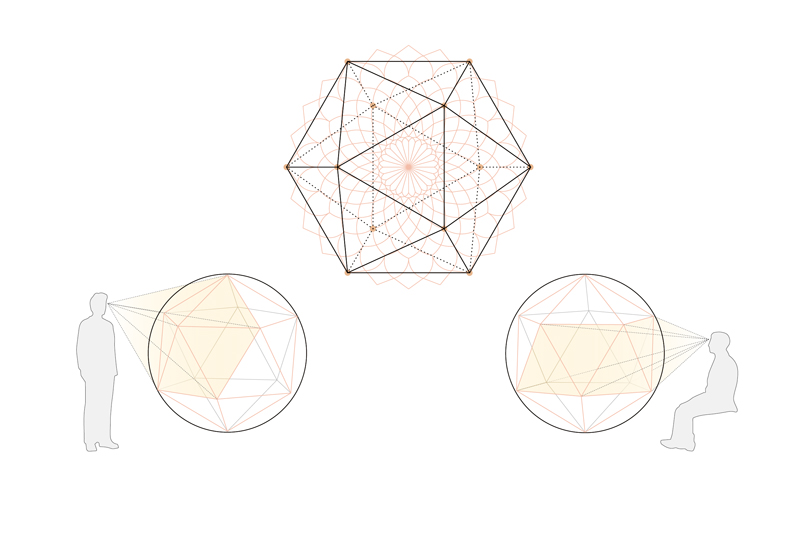
We looked for the right dimension of the sphere and the geometric decomposition that would allow us to obtain a different mandala for each of the points of view in which the observer can be located.
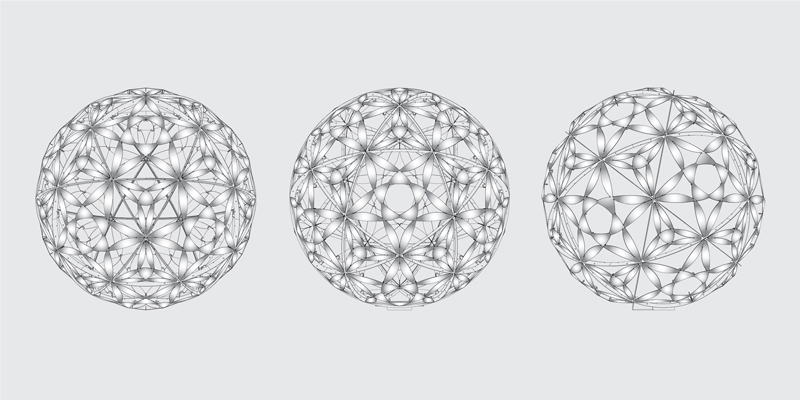
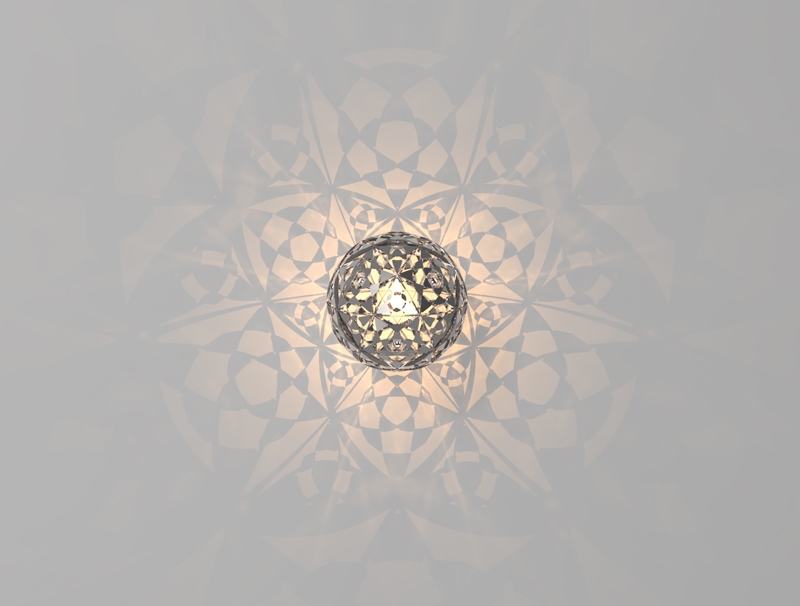
Materialization
When deciding on the construction system, we always take into consideration that the complexity and therefore the price of the parts to be manufactured increases as we add degrees of curvature. A sphere is an object with double curvature. There is no possible section in which a sphere results in a straight line. To decompose the shape into flat portions we again had to resort to polyhedra.
The structure chosen for the sphere was composed of pentagons and triangles with a size that was ideal for both shipping and assembly. However, it was still necessary to provide the piece with a greater degree of richness of detail considering that the observer could even touch it.
Breaking down the geometry of the modules into small planes was a complex geometric exercise that simplified fabrication while creating undeformed reflections of the landscape by means of mirrored flat pieces always perpendicularly oriented to the center of the sphere.
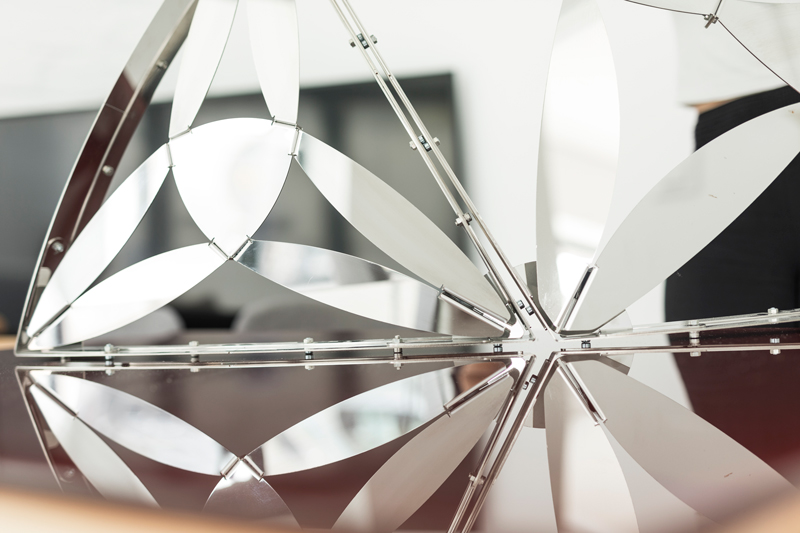
Simplifying the construction system also eliminates the need for prototyping. If you do not prototype a unique piece, if the prototype is only virtual, you directly reduce costs by 50%. This is an advantage we usually cannot do without.
With regard to structural design, the biggest challenge is to create sufficiently robust pieces by integrating the structural solution into the overall design concept. We always try to avoid applying structural solutions that are dissociated from the original shape, thus avoiding the appearance of elements that only have a structural function.
In this case, the actual subdivision of the sphere into pentagons and triangles is generated by the disposition of six rings arranged in different directions. These flat section rings are the structure, the fixing points of the modules and they also hide the electric cable that powers the light that illuminates the piece from the top. All the components form part of a whole in which the hierarchy of elements is not perceived.
Transport & Assembly
With a vocation to provide our services internationally, it is essential that the design is conceived from the idea of minimizing the number of components to be assembled on site.
One of our greatest challenges is always to try to ensure that our presence on site is not indispensable. This requires a lot of synthesis in the design. We face the great difficulty of making everything look easy. Moreover, it is only by synthesizing that we can achieve elegance.
Our team of designers is present at the pre-assembly in Barcelona to detect and correct all possible errors in the piece and to ensure a rewarding experience for the team in charge of the installation on-site.
It is very important that the piece is easy to assemble, not only because this means that it is not essential to send a team from the other side of the world with the extra costs and coordination difficulties that this entails, but also because a piece that is easy to assemble is also a piece that is easy to disassemble and maintain.
Result
As a result, we obtained a three-dimensional Mandala that plays with reflections, shadows, transparency, and the different points of view from which we can observe it.

